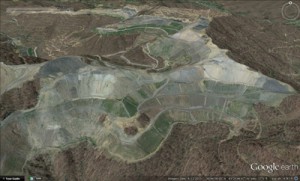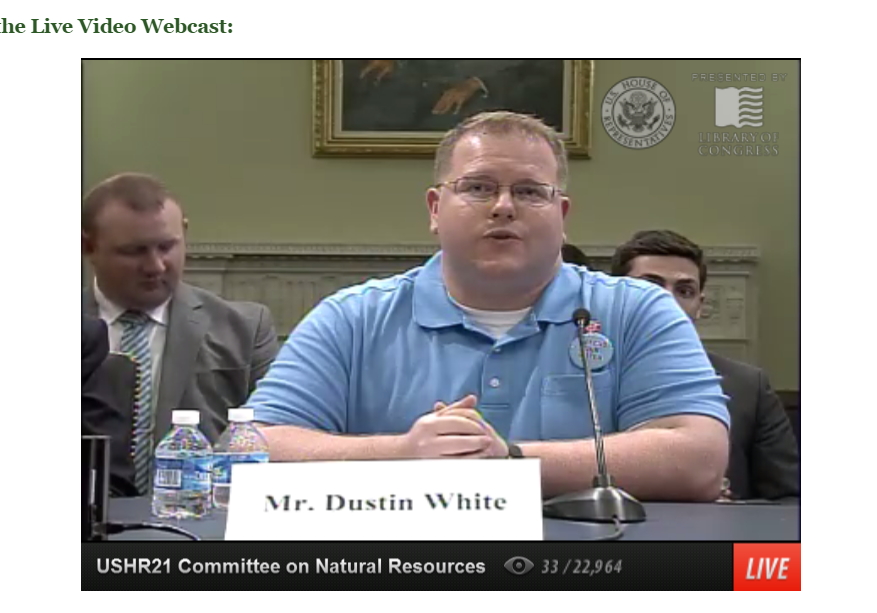News
Cross-posted from AppVoices.org

As even some of the largest U.S. coal producers run the risk of caving under their debts, officials that oversee the federal surface mine bonding program are voicing urgent concerns about companies’ ability to pay for post-mine reclamation.
After bankruptcies, legal fees, fines, plummeting share prices and years without a profit in sight, another aspect of the financial perils U.S. coal companies face is coming into full view.
Recently, regulators worried about the ability of coal companies to pay for post-mine reclamation have begun scrutinizing a practice known as “self-bonding,” which allows a company to insure the cost of restoring the land after mining without putting up collateral, provided it meets certain financial criteria.
Reuters reported last week that Peabody Energy, the world’s largest private-sector coal company, is under the microscope and may be violating federal bonding regulations under the 1977 Surface Mine Control and Reclamation Act.
Peabody, which reported a $787 million loss in 2014, had roughly $1.38 billion in clean-up liabilities insured by self-bonding at the end of March, according to the report. In fact, as its finances deteriorate, analysts say Peabody is warping the language of the law and pointing to the relative strength of its subsidiaries’ balance sheets to continue meeting self-bonding requirements.
Peabody is not alone. Arch Coal, which Reuters found has also failed the financial test to meet self-bonding requirements, is restructuring its multibillion-dollar debt. The company ended 2014 with $418 million in cleanup liabilities and hasn’t turned a profit since 2011.
On May 29, Alpha Natural Resources received word from the Wyoming Department of Environmental Quality that it is no longer eligible to self-bond in the state. The company now has less than 90 days to put up $411 million in anticipated mine cleanup costs. The nation’s second-largest producer by sales, Alpha told investors earlier this year that it had $640.5 million in reclamation liabilities at its mines in Appalachia and Wyoming’s Powder River Basin.
Watching as even some of the largest U.S. coal producers run the risk of caving under their debts, officials that oversee the federal bonding program are voicing urgent concerns to state officials.
In April, the U.S. Office of Surface Mining Reclamation and Enforcement sent a letter to West Virginia Department of Environmental Protection urging that the state conduct a fuller analysis of future risks �” not just rely on historic data �” to calculate reclamation costs.
“Given the precarious financial situation” of companies operating in West Virginia, the letter states, regulators should closely examine the risk of failure for sites with markedly more expensive liabilities such as pollution treatment facilities.
From where we’re standing, it’s tough to see how the situation could improve. Taken together, the country’s four largest coal companies �” Peabody, Alpha, Arch Coal and Cloud Peak Energy �” have about $2.7 billion in anticipated reclamation costs covered by self bonding. Bloomberg News reported in March that nearly three quarters of Central Appalachian coal is mined at a loss.
As the problem grows, regulators and advocates for reform face their own predicament. Stricter self-bonding standards and enforcement push cash-strapped companies closer to bankruptcy. But inaction could leave taxpayers to pick up the bill if companies with unreclaimed mines eventually crumble.
No comments yet » Leave your own...
Last week, our friend Dustin White traveled back to Washington, DC to speak up for the mountains. The House Committee on Natural Resources was having an Oversight Hearing on “State Perspectives on the Status of Cooperating Agencies for the Office of Surface Mining’s Stream Protection Rule.” At issue in this hearing is the cooperation between the state and federal government on the protection of Appalachian streams and the development of the anticipated Stream Protection Rule that the Office of Surface Mining has been developing since 2009.

Dustin captured the issue well,
Most of the Appalachian states with mountaintop removal have their own regulatory agencies that are supposed to be the first line of defense for communities when coal companies violate the law. These agencies exist in KY, VA, and in WV we know them as the DEP or Department of Environmental Protection. But many in WV say DEP stands for something else… “Don’t Expect Protection” as citizens often find themselves doing the job of the DEP to monitor the impacts of mining. We have found that the state regulatory agencies often issue mining permits against objection of citizens and sometimes without the proper environmental surveys required by law. They often allow coal companies that are habitual violators of the law to operate with little to no interruption. Fines issued for violations are little more than pocket change for coal companies.
In at least WV and KY the regulatory agencies and state legislatures worked lower water quality standards that go against federal guidances, allowing companies to discharge higher levels toxic selenium and aluminum into streams. Agencies like the DEP seem to be working against the best interest of the people and because of this citizens often turn to legal action to reign in coal companies. We have even filed a 733 petition under SMCRA in WV asking OSMRE to intervene in DEP’s mining division for failing to do their job.
The lack of protection many communities face when mountaintop removal threatens their water has been blamed, in part, on lack of oversight by state agencies. Therefore many have looked to the federal government and to Congress to protect their land and water from this devastating practice.
Thanks to Dustin for taking time out of his busy work organizing with people who’ve seen the worst impacts of the coal industry and sharing his experience with those in DC! Let’s hope that those in charge of enforcing the law in West Virginia were listening in.
No comments yet » Leave your own...
Healthy critters in our streams are an important sign that the water is safe for all life. So it’s key that we keep an eye on the crawdads!

Big Sandy crayfish photo by Guenter Schuster.
Our friends at Center for Biological Diversity have created a petition and lawsuit that forced the U.S. Fish and Wildlife Service to propose to protect two species of crayfish from Appalachia under the Endangered Species Act. The crayfishes have been lost from more than half of their ranges because of water pollution, primarily from coal mining. The Big Sandy crayfish is known only from the Big Sandy River basin in eastern Kentucky, southwestern Virginia and southern West Virginia; the Guyandotte River crayfish is known only from the Guyandotte River basin in southern West Virginia.
This listing proposal means that federal agencies will now have to confer with the U.S. Fish and Wildlife Service before funding or permitting any activity that could harm the animals. When the listing is finalized in 12 months, it will be illegal for any person or corporation, including coal companies, to harm the crayfishes or their habitat. The Service will propose critical habitat to protect the crayfishes in the near future.
No comments yet » Leave your own...
Announcing a new tool to end the destruction of Appalachian mountains and streams
Coal is in the news a lot these days. The market forces and much-needed environmental and health protections cornering the dirty fuel are topics of endless interest as America’s energy landscape shifts toward cleaner sources. And yes, all signs point to coal’s continued decline.
In many ways though, the forces chipping away at coal’s historic dominance are overshadowing another big story �” one that Appalachian citizens still need the public and policymakers to hear �” about just how much the human and environmental costs of mountaintop removal coal mining persist in Central Appalachia.
That mountaintop removal is an extremely dirty and dangerous way to mine coal has never been better understood. The overwhelming body of evidence is built on a foundation of the countless personal stories found in communities near mines and bolstered by dozens of studies investigating disproportionate health problems in coal-producing counties compared to elsewhere in Appalachia. More recently, advocates have employed technological tools to visualize complex data and add another dimension to arguments against the practice.
Appalachian Voices is committed to both creating a forum for those personal stories and sharing the most up-to-date data available about the ongoing risks mountaintop removal poses to our region’s communities and environment. Today, we’re excited to share a web tool we developed to reveal how mining continues to close in on nearby communities and send a resounding message to President Obama that ending mountaintop removal is a must if we hope to foster economic and environmental health in Appalachia.
Explore Appalachian Communities at Risk from Mountaintop Removal on iLoveMountains.org
The centerpiece of “Communities at Risk from Mountaintop Removal” is an interactive mapping tool on iLoveMountains.org that allows anyone to explore mountaintop removal’s expansion over the past 30 years.
Created using Google Earth Engine, U.S. Geological Survey data, publicly available satellite imagery, and mapping data and consultation from the nonprofit SkyTruth, the tool gives users greater perspective into the decades-long scourge surface mining has had on the Appalachian landscape and generations of families that live in the region.
The Communities at Risk tool also concentrates on impacts at the community level, where the powerful personal stories that first brought mountaintop removal to the forefront of the nation’s consciousness and agenda for environmental change are found.
Fifty communities spread across Kentucky, Virginia and West Virginia are identified by the tool as being the most at risk. By clicking on a community icon on the map, you can see the number of acres classified as active mining within a 1-mile radius of a particular place over time. In some communities, the number has fallen. In others, it has grown dramatically in recent years even as regional coal production has plummeted.
In the coming months, we’ll take a closer look at a handful of these communities, sharing local perspectives on how the proximity of mountaintop removal has affected local livelihoods. Our first “featured community” is Inman, Va., a small town in Wise County, where residents have successfully battled back a proposed massive mountaintop removal mine while experiencing the devastating impacts of another. You’ll also see stories about featured communities on AppalachianVoices.org and in upcoming issues of The Appalachian Voice newspaper.
Learn about Inman, Va., from local residents Matt Hepler and Ben Hooper
If you want a fuller picture of the data we used to create the mapping tool, check out the companion white paper, which describes the background, methods, results and implications of our initial research.
Over time, we’ll work with impacted citizens in communities near active and proposed mines to expand the use of the tool and update our maps with current, high-resolution satellite imagery we’ll obtain through a partnership with Google’s Skybox for Good project. We’ll use those images to improve interactions between citizens and regulators, share information with our allies and
Read our white paper for an in-depth look at the ways mountaintop removal continues to put Appalachian communities at risk.
The constant flow of news describing something close to the death of the Appalachian coal industry could leave outside observers with the impression that the problems of mountaintop removal have been resolved by the industry’s collapse. That impression, however, is at odds with the personal experience of many Appalachian citizens, the visible impacts of mining in communities across the region and the data that comprises Communities at Risk.
Visit communitiesatrisk.org to explore the mapping tool, learn more about the 50 most at-risk communities and tell President Obama that more must be done to protect Appalachian communities.
1 Comment » Leave your own...

Art by Katie Hanna
The STAY Project (Stay Together Appalachian Youth) is a diverse regional network of young people throughout Central Appalachia who are working together to advocate for and actively participate in their home mountain communities. The group has created the #AppalachianLoveStory Radio Stories to showcase the complicated relationship and Appalachian Pride youth have with Appalachia.
This article highlights one of the programs created for Appalachian Love Story, and more stories can be found in this episode of Inside Appalachia below.
No comments yet » Leave your own...
From the press release:
On March 17th, seven local, regional and national groups filed a formal notice of intent to sue the U.S. Office of Surface Mining for failing to intervene on West Virginia’s lax oversight of mountaintop-removal and other destructive surface coal mining �” a state program that has, for decades, allowed the coal industry to ravage the environment, putting people at risk and destroying local communities.
The state’s chronically poor oversight has included a persistent failure to conduct inspections meant to protect people and the environment from coal companies that operate outside the law. Out-of-control mountaintop-removal coal mining is linked to epidemics of cancer, cardiovascular disease and birth defects in affected communities. West Virginia has also failed to undertake required assessments to ensure lakes, rivers and drinking-water wells aren’t harmed by mountaintop-removal mining and other destructive surface coal-mining practices.
Learn more about this important case at Coal River Mountain Watch’s website.
1 Comment » Leave your own...

Putting Their Foot Down: Hundreds Rally at WVDEP
Several hundred people gathered in Charleston, WV on Monday, March 16th for the People’s Foot rally at the West Virginia Department of Environmental Protection. The event was hosted by a coalition of West Virginia groups demanding an end to mountaintop removal and working to highlight the devastating effects of mountaintop removal on the health of local residents. MTR and health issues.
In an exciting update, the day after the People’s Foot rally, state officials agreed to examine the science on the links between MTR and health issues. According to this Charleston Gazette article, Bureau for Public Health Commissioner Dr. Rahul Gupta said, “The analysis is something that is needed going forward. The bottom line here is to let science speak for itself. It’s time that we attempt to do that.”
Another powerful example of People Power in Appalachia!
No comments yet » Leave your own...

The AML Policy Priorities Group is a multi-stakeholder group initially formed to inform the Abandoned Mine Lands Fund research project of two Appalachian Transition Fellows and their host organizations: Kendall Bilbrey, The Alliance for Appalachia and Eric Dixon, Appalachian Citizens’ Law Center.
Other recent work from this program includes an Ask the Director Meeting with the Office of Surface Mining, Reclamation and Enforcement (OSMRE) in Washington, DC. During the meeting, Director Joe Pizarchik and his staff answered questions from citizens about the agency’s work. Several Alliance for Appalachia members joined coalfields citizens across the country in person and by phone. This meeting was coordinated by Citizens’ Coal Council.
The group is launching a spring AML Educational Tour to share their research with communities across Appalachia. The goal of our research is to recommend policy change through our AML Whitepaper, and share the paper with communities and organizations so they can learn more about how the fund works, and what policy changes are necessary for leveraging these funds into our communities.
Updated AML Educational Tour Schedule
- KFTC Land Reform Committee, Prestonsburg KY (Postponed from Weather, TBA)
- AML Policy Priorities Group Conference Call: March 18th 11am
- 760-569-6000, PIN: 465-754
- Society for Applied Anthropology Conference, Pittsburgh PA�” March 24th
- Appalachian Studies Association Conference, Johnson City TN�” March 27th-29th
- AML Policy Priorities Group In-Person Meeting, Benham KY�” April 2nd
- SOCM Chapter Tour, East TN �” April 6th-9th
- Clearfork Community Institute, Eagan TN �” April 9th
- Foundation for Appalachian Kentucky, Hazard KY�” May 8th
Questions about the tour? Contact Kendall@TheAllianceforAppalachia.org
If you’re interested in getting more involved in this work, you might join us for the AML In-Person Meeting, April 2nd at the Benham Schoolhouse Inn. Join us for our second in-person meeting in Benham, Kentucky as we discuss our work, present our paper, strategize for the future of the group, and have a collaborative space to learn and build networks.
No comments yet » Leave your own...
On Monday, March 16, those fed up with the toxic legacy of coal in West Virginia are gathering at the Department of Environmental Protection’s headquarters in Charleston to declare: “No More Mountaintop Removal Permits!”

A year after the coal chemical disaster that endangered the health and local economy for more than 300,000 people, and in the face of 25 peer-reviewed scientific studies showing the devastating connections between people’s health and mountaintop removal, a diverse coalition known as “The People’s Foot” is putting their foot down at the West Virginia Department of Environmental Protection and demanding real change and real protections for West Virginia.
Come to the WVDEP headquarters at 601 57th Street Southeast, Charleston, WV 25304 from 11:00-1:00 on Monday, March 16 for “No More MTR Permits Day.” Let them know that we will not tolerate more threats to our people’s health. Get a free t-shirt if you’re one of the first 125 people to show up. Signs will be provided, so come on down and bring a friend!
To learn more about the event and RSVP, visit the facebook page!
Hope to see you in Charleston next Monday!
No comments yet » Leave your own...

Great news! Quakers win a major victory in the fight against MTR!
After five years of action by Earth Quaker Action Team, PNC announced Monday a shift in its policy that will effectively cease its financing of mountaintop removal coal mining in Appalachia.
This successful campaign shifted the policy of the seventh largest U.S. bank! This marks a major turnaround for PNC, who for years refused to budge on this issue. After more than 125 actions, their desire to continue business as usual proved no match for EQAT and allies. Bowing to pressure from Quaker environmentalists, PNC Bank announced that it will be restricting financing of mountaintop removal coal mining in Appalachia. The shift outlined in its 2015 Corporate Responsibility Report means PNC Bank will effectively cease its investment in this controversial practice.
In 2012 PNC Bank financed Alpha Natural Resources, Arch Coal, CONSOL Energy, and Patriot Coal, which together were responsible for nearly half (44.97%) of Appalachian mountaintop removal production. PNC’s total investment was $687.5 million for that year.
The grassroots group leading the charge for PNC’s new policy, Earth Quaker Action Team, hails the change as a major shift by the seventh largest US bank. “When we initiated our campaign in 2010, PNC attempted to placate us with a hollow policy. It’s good to see that PNC Bank is now taking meaningful steps,” says Matthew Armstead, staff coordinator for EQAT. “Since this shift happened because of external pressure, it should be a wake-up call for everyone that the power of change lies with regular citizen activists.”
Read more about this victory on EQAT’s website.
No comments yet » Leave your own...

















